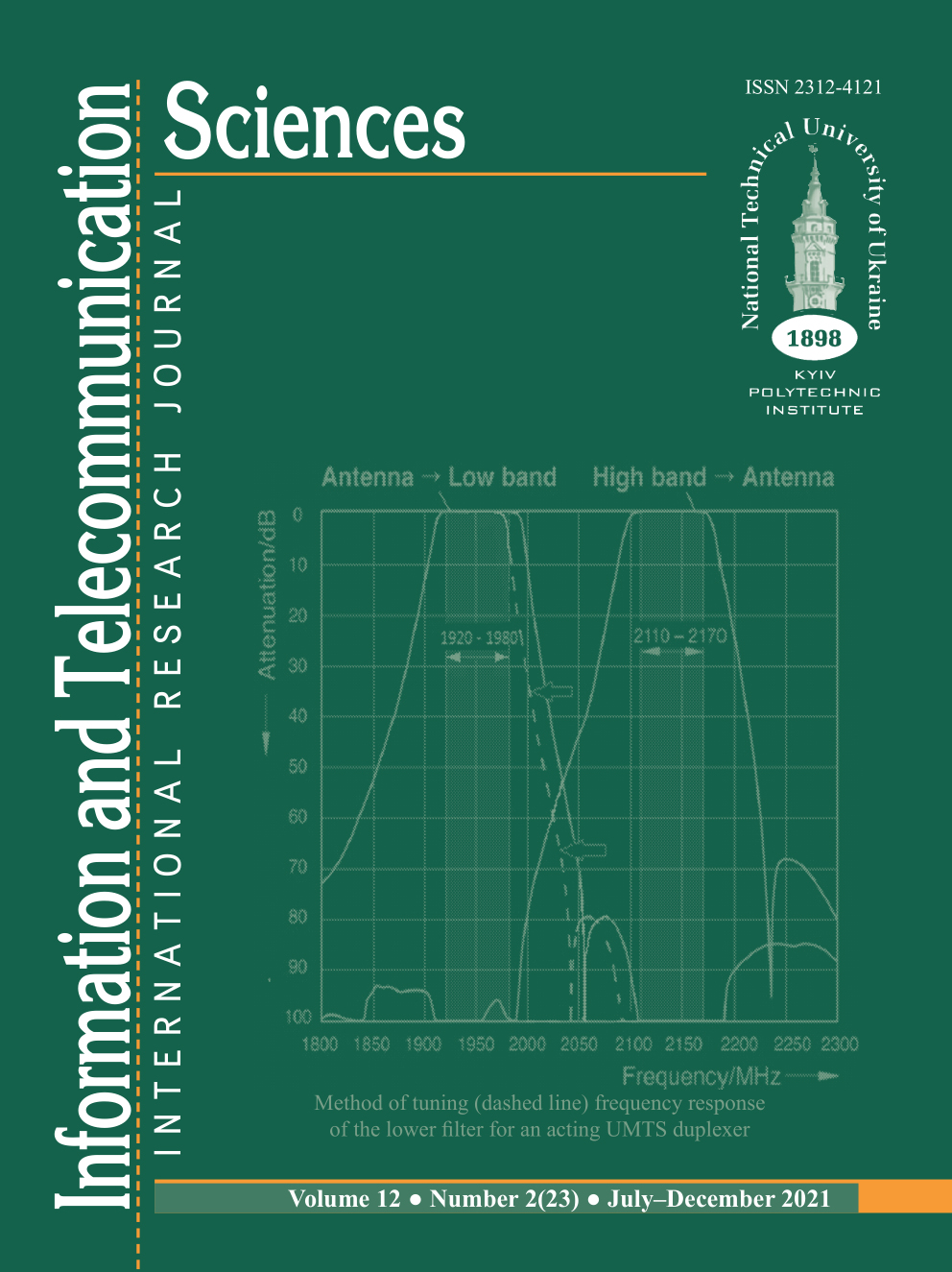OBTAINING CONDITIONS FOR TECHNOLOGY NEUTRALITY OF COMMUNICATION SYSTEMS WITH MINIMUM COUPLING LOSS METHOD
DOI:
https://doi.org/10.20535/2411-2976.22021.27-39Keywords:
parameters of compatibility, adjacent channel leakage, adjacent channel selectivity, minimal guard band, additional filtering, steepness of frequency responseAbstract
Background. Technology neutrality is widely used in frequency bands, where communication systems are evolving, but there are strict restrictions on the parameters and deployment of base stations of different technologies using adjacent channels. Ways to mitigate this effect have not been sufficiently studied and require further analysis and development.
Objective. The purpose of this article is to investigate the methodology for obtaining technical conditions of technological neutrality with minimum coupling loss method to determine the value of additional filtering requirements and present the results of practical implementation of this technique.
Methods. The method of detailed power analysis of frequency characteristics of filters for base stations’ transmitter and receiver is applied.
Results. The article presents the results of obtaining minimal guard band and additional filtering requirements in the adjacent channels of transmitter and receiver belonging to different technologies. Examples of practical implementation of the minimum guard band and frequency characteristics of additional filters are given.
Conclusions. The general method of determining the technical conditions for ensuring technology neutrality is presented and the value of the minimal required guard band between the adjacent transmitter and receiver channels is obtained.
References
Framework Directive 2002/21/EC, ‘common regulatory framework for electronic communications networks and services’, Official Journal L 108 , 24/04/2002, March 2002. pp. 0033 – 0050. Retirieved from ttps://www.eumonitor.eu
“Enhancing Harmonisation and introducing flexibility in the spectrum regulatory framework”, ECC Report 80, Murch 2006, pp.2-98. Retirieved from https://docdb.cept.org/document/ category/ECC_Reports
Report from CEPT to the European Commission in response to the Mandate to develop least restrictive technical conditions for frequency bands addressed in the context of WAPECS CEPT Report 19, October 2008, pp. 3-92. Retirieved from https://docdb.cept.org/document/category/CEPT_Reports
Evaluation of Co-existence interference between CDMA 1900 MHz & UMTS 2100 MHz, AUSPI Report. October 2007, pp. 2-11. Retirieved from http://www.cdg.org/resources/ files/white_papers
V.I. Korsun, “Technical aspects of harmonization of radio frequency resource of Ukraine for the use when implementing up-to-date and promising radio technologies”, Proceedings of the ITU Workshop for the European Regions and the CIS "Information and Communication Technology Infrastructure as a Basis for Creating a Digital Economy", Kyiv, STU, May 2019. Retirieved from http://www.dut.edu.ua/ua/1867-materiali-konferencii-seminar-praktikum-mse-dlya-regioniv-evropi-ta-snd-infrastruktura-ikt-yak-osnova-cifrovoi-ekonomiki
Practical mechanism to improve the compatibility between GSM-R and public mobile networks and guidance on practical coordination, EСС Report 162, May 2011, p.p. 2-53 Retirieved from https://docdb.cept.org/document/category/CEPT_ Reports
Report from CEPT to the European Commission in response to the Mandate to develop least restrictive technical conditions for 2 GHz bands, CEPT Report 39, June 2010, pp.2-61. Retirieved from https://docdb.cept.org/ document/ category/ CEPT_Reports
Coexistence between mobile systems in the 2.6 GHz frequency band at the FDD/TDD boundary, ECC Rep119, 10 p. Retirieved from https://docdb.cept.org/document/category/ CEPT_Reports
Sharing and adjacent band compatibility between UMTS / / IMT-2000 in the band 2500-2690 MHz and other services, ECC REPORT 45, 37 p. Retirieved from https://docdb.cept.org/document/ category/CEPT_Reports
Compatibility/sharing studies related to PMSE, DECT and SRD with DA2GC in the 2 GHz unpaired bands and MFCN in the adjacent 2 GHz paired band, ECC Report 220, September 2014, pp. 2-137. Retirieved from https://docdb.cept.org/document/category/ECC_Reports
Compatibility between RMR and MFCN in the 900 MHz range, 1900-1920 MHz band and 2290-2300 band, EСС Report 318, July 2020, pp.2-123. Retirieved from https://docdb.cept.org/document/category/ CEPT_Reports
Yoo Seung Song, Shin Kyung Lee, Jeong Woo Lee, Do Wook Kang, and Kyoung Wook Min, “Analysis of adjacent channel interference using distribution function for V2X communication systems in the 5.9 GHz band for ITS”, ETRI Journal, V 41, Issue 6, September 2019, pp. 703-714. Retirieved from https://onlinelibrary.wiley.com/doi/ full/10.4218/ etrij.2018-0249
Erik Dahlman, Stefan Parkvall and Johan Sköld, “22.9.3 Adjacent Channel Leakage Ratio” in 4G LTE-Advanced Pro and The Road to 5G (Third Edition), 2016, pp. 487-526. Retirieved from https://www.sciencedirect.com/topics/engineering/ adjacent-channel-interference
Resolution № 295 of 14 May 2015 of the Cabinet of Ministers of Ukraine on Amendments to the Resolution № 815 of 9 June 2006 on Approval of the Plan for the Use of Radio Frequency Resources of Ukraine. Retirieved from https://zakon.rada.gov.ua/laws/show/295-2015
Calculation of free-space attenuation, ITU-R Recommendation P.525-4 (08/2019). Available: https://itu.int
Characteristics of terrestrial IMT-2000 systems for frequency sharing/interference analysys, ITU-R Report M.2039-3, 20 p., Noveber 2014. Retirieved from https://itu.int
LTE; Evolved Universal Terrestrial Radio Access (E-UTRA); Base Station (BS) radio transmission and reception, 3GPP Technical Specification TS 36.104 version 11.2.0 Release 11, ETSI Technical Specification TS 136 104 V11.2.0, 2012-11
Universal Mobile Telecommunications System (UMTS); Base Station (BS) radio transmission and reception (FDD), 3GPP Technical Specification TS 25.104 version 8.2.0 Release 8, ETSI Technical Specification TS 125 104 V8.2.0, 2008-04
BBTRX-05 PCS RRH 4x45W Test Report Alcatel-Lucent USA, June 2015. Retirieved from https://fccid.io/AS5BBTRX-05/Test-Report/Test-Report-2673912
V.I. Korsun, “Frequency provision for introduction and development of broadband mobile communication networks in Ukraine”, Proceedings of the ITU Regional Seminar "Trends in Convergent Networks: Post-NGN, 4G and 5G Solutions", Kyiv, STU, November 2016, pp. 70–72.
V.I. Korsun, V.F. Korsak, T.M. Naritnik and O.V. Lutchak, “New solutions for ensuring electromagnetic compatibility between base stations of communication systems in adjacent frequency bands”, Proceedings of the 6th International Radioelectronic Forum “Applied Radioelectronics. State-of-Art and future development” (IRF-2017), Kharkiv, 2017, pp. 273–277.
V. I. Korsun, V.F. Korsak and T.M. Naritnyk, “Electromagnetic compatibility between base stations of UMTS standard mobile communication and broadband wireless access systems: development, testing, certification”, Proceedings of the 3rd International Scientific and Technical Conference "Problems of electromagnetic compatibility of promising wireless communication networks” (EMC 2017), Kharkiv, 2017, pp. 36–42.
Test Report №D1FH0005. Nokia Siemens Networks Oy (NSN) Flexi WCDMA BTS 2100 MHz Conformance test according to ETSI EN 301 908-3 V4.2.1, Center for Quality Engineering. Munick, 2010, pp. 3-40
Kathrein 698-6000 MHz catalogue, Duplexer 1920-1980/2110-2170 MHz (UMTS), 2012, 238 p. Retirieved from https://www.olifantasia.eu/gnuradio/usrp/files/datasheets
RF System Scenarios. 3GPP Technical Specification RAN 25.942 V11.0.0, October 2012, pp. 3-136. Retirieved from https://www.etsi.org/deliver/etsi_tr/125900_125999/125942/11.00.00_60/tr_125942v110000p.pdf


